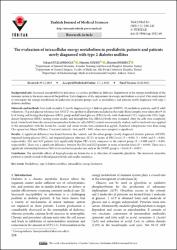| dc.contributor.author | Özden, Hüseyin | |
| dc.contributor.author | Dulkadiroğlu, Erkan | |
| dc.contributor.author | Demirci, Hüseyin | |
| dc.date.accessioned | 2022-05-16T07:05:12Z | |
| dc.date.available | 2022-05-16T07:05:12Z | |
| dc.date.issued | 2021 | tr |
| dc.identifier.citation | Dulkadiroğlu E, Özden H, Demirci H. The evaluation of intracellular energy metabolism in prediabetic patients and patients newly diagnosed with type 2 diabetes mellitus. Turkish Journal Of Medical Sciences. 2021, 51 (1): 238-245. Doi: 10.3906/sag-1912-60 | tr |
| dc.identifier.uri | https://hdl.handle.net/20.500.12418/13118 | |
| dc.description.abstract | Background/aim: Increased susceptibility to infections is a serious problem in diabetics. Impairment in the energy metabolism of the
immune system is the main source of the problem. Early diagnosis of the impairment in energy metabolism is crucial. Our study aimed
to investigate the energy metabolism in leukocytes in patient groups such as prediabetics and patients newly diagnosed with type 2
diabetes mellitus.
Materials and methods: Our study included 21 newly diagnosed type 2 diabetic patients (NDDP), 30 prediabetic patients, and 22 adult
volunteers. 75 g oral glucose tolerance test (OGTT) was applied to all patients included in the study. Blood samples were taken after 9-16
h of fasting and fasting blood glucose (FBG), postprandial blood glucose (PBG) levels, total cholesterol (TC), triglyceride (TG), highdensity
lipoprotein (HDL), fasting serum insulin, and hemoglobin A1c (HbA1c) levels were evaluated. After the cells were completely
lysed, citrate levels from the released mononuclear leukocyte cells (MNC) content were manually studied, and lactate levels were applied
to the autoanalyzer with the lactate kit. Lactate and citrate results were calculated as μg/mL. Statistical comparisons were done using
Chi-square test, Mann-Whitney U test and student’s t test, and P < 0.05 values were accepted as significant.
Results: A significant difference was found between the controls and the other groups (newly diagnosed diabetic patients (NDDP),
impaired fasting glucose (IFG), and impaired glucose tolerance (IGT)) in terms of FBG levels (P < 0.001, P < 0.001 and P < 0.001,
respectively). IFG and IGT patients had significantly higher PBG levels compared to the control group (P = 0.009 and P < 0.001,
respectively). There was a significant difference between the IFG and IGT patients in terms of insulin levels (P = 0.019). There was a
significant relationship between FBG levels and lactate production only in the NDDP group (r = 0.610, P = 0.003)
Conclusion: The metabolic effects of hyperglycemia on leukocytes is in direction of anaerobic glycolysis. The increased anaerobic
pathway is closely related to blood glucose levels and insulin resistance. | tr |
| dc.language.iso | eng | tr |
| dc.rights | info:eu-repo/semantics/openAccess | tr |
| dc.subject | Prediabetes, type 2 diabetes mellitus, intracellular energy, leukocyte | tr |
| dc.title | The evaluation of intracellular energy metabolism in prediabetic patients and patients newly diagnosed with type 2 diabetes mellitus | tr |
| dc.type | article | tr |
| dc.contributor.department | Tıp Fakültesi | tr |
| dc.contributor.authorID | 0000-0002-2786-3805 | tr |
| dc.relation.publicationcategory | Uluslararası Hakemli Dergide Makale - Kurum Öğretim Elemanı | tr |















